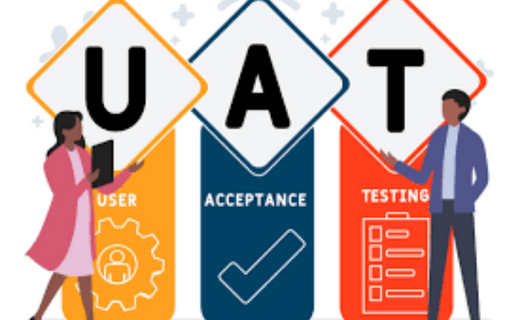-

How to Conduct User Acceptance Testing (UAT)?
Imagine this; you pour your blood, sweat and tears into building a product. You think it’s the best thing since sliced bread. The product passes quality tests, and you launch it in the market. But soon, you find that people are not using your product. You watch in horror as you realize all that hard work was for nothing. You wake up with a shudder; it was just a dream. This nightmare is a real possibility, so how to keep it from turning into reality?
Software testing is essential when creating any digital product. It allows you to check your software and ensure it is high-quality and safe for users. Finding bugs in your product is only half the battle. Users may not like your product if it doesn’t meet their expectations. That’s where user acceptance testing can help!
Companies that want to keep their digital products running smoothly actively invest in testing. As the industry grows, the global software testing market will surge to $60 billion in 2027, compared to $40 billion in 2020.
This article will show you what user acceptance testing is, when you should conduct UAT, and how to perform UAT.
What Is the Difference Between UAT and QA?
People frequently refer to the QA process when talking about user acceptance testing. These notions, however, should be differentiated since they serve distinct purposes. Let’s go through UAT and QA one by one.
User acceptance testing (UAT) is a testing approach that ensures a product satisfies the business and its end-users demands. This type of testing is also referred to as beta or end-user testing.
Quality assurance (QA) is a set of activities covering all stages of software development, release, and operation. These activities aim to ensure the quality of the digital product before its launch.
What distinguishes UAT and QA?
First of all, QA is an umbrella term. It consists of various testing approaches, including functional, system, and regression testing. Only when the quality assurance procedure has been completed does UAT begin.
In this context, we should also pay attention to verification and validation concepts:
- The verification is directly related to the QA process. It aims to verify the technical aspects of the product. It results in high-quality software that works without limitations and errors.
- The validation applies to UAT and aims to confirm that the product meets user requirements and business objectives.
User acceptance testing is the last stage before launching a digital product on the market. It can be divided into two main types:
- Alpha testing is acceptance testing conducted by in-house testers to verify that a product meets business needs.
- Beta testing is checking users’ acceptance of a product. It is conducted among a group of end-users or stakeholders of the company, i.e., people who are not professional testers.
Why Conduct User Acceptance Testing (UAT)?
Developers and QA specialists can check the technical aspects of your product. They will take into account its functional features and fix any issues. Yet, even with a technically perfect product, you still can’t be 100% sure that users will like it.
Let’s now discuss why UAT is important. Here are some reasons:
Compliance with Business Objectives
UAT allows you to test how your digital product behaves in actual conditions among real users. This testing helps you identify flaws in your software that you may have missed during the QA process.
Product Improvement
During user acceptance testing, end-users can share interesting insights for improving your software. As a result, you can make your product even more customer-centric.
Preventing Losses
Refining your product and fixing bugs before it hits the market is best. Correcting issues before the release will be much cheaper, plus you will avoid user dissatisfaction. It is a particularly manageable task for development teams using the Agile methodology and a crucial step in the software testing in the Waterfall model.
Planning Phase of User Acceptance Testing
Conducting user acceptance tests requires careful preparation. The planning phase includes several fundamental steps:
Step 1. Define Your Objectives
First, determine what results you expect from user acceptance testing. To do this, you need to review your business needs and inform your team about their role in testing.
Testing goals will vary depending on the type of your digital product and the industry in which your business operates.
Step 2. Prepare Test Scenarios for User Acceptance Testing
To test each element of your digital product, you will need to create separate test cases. They should describe the specific actions users will perform when operating your product. You can begin by describing typical interactions with your product and then move to more unusual situations.
Creating a UAT test scenario involves adding the following info:
- Test case title
- List of steps
- User results
- Task priority
- Passing status
- User feedback
Step 3. Choose Who Will Perform User Acceptance Testing
You can now select test participants based on your goals and ready-made test scenarios.
You can engage your testers’ team to conduct alpha testing. Or you may delegate UAT to outsourcing providers if there are not enough in-house employees to do this job.
For beta testing, you need to gather a group of end-users who may be interested in your product. Consequently, you can conduct testing in a real environment.
Conducting UAT Testing
After the UAT planning phase, you can proceed directly to conducting user acceptance testing. Here’s what you need to do:
User Acceptance Testing Execution
Once you have prepared the test scenarios and cases and found the participants, you can start the UAT testing process.
Testing usually takes place in a separate room, where your QA specialists and project managers are with the rest of the test participants. The user acceptance testing process can take several sessions over several days.
You must start by instructing the participants on how to perform the tasks correctly, how to fill in the test scenario forms according to each criterion, and provide feedback. After that, end-users can begin to complete the test cases.
During testing, your company’s employees should monitor work progress and assist participants in case of any questions or issues.
Documenting User Acceptance Test Results
As a result of the UAT testing, you get a lot of valuable data from your users. At the end of the test session, your employees can also conduct participant surveys and record the information received. Then, you’ll have the documents with feedback and comments.
User Acceptance Testing: Evaluation and Reporting
After testing, you have plenty of data that your QA specialists will need to study. After careful analysis, you will get a report with key deliverables.
- How the process of evaluating test results is carried out:
- Your specialists assess whether users have achieved the goals you set.
- QA experts consider failed tests and identify what problems have arisen.
- Your specialists think about how to solve existing problems.
- QA experts analyze quantitative and qualitative data: the number of tests performed, the number of failed tests, the overall assessment of test scenarios, etc.
Then your QA specialists initiate the reporting phase. It involves drawing conclusions based on evaluated data. Your employees will build a strategy to improve your project and correct errors.
How to Make User Acceptance Testing Valuable?
Let’s look at best practices to make your UAT testing strategy valuable and effective. Using these methods, you can get valuable insights from your testing. Here’s what you should pay attention to
- Prepare for the UAT in advance, preferably in the early stages of your product development.
- Before testing, be sure to create UAT checklists in which you will describe the main goals and objectives.
- Before conducting beta testing involving end-users, execute UAT among your employees.
- Clearly and concisely describe the goals and expected test results.
- When creating a UAT test plan, prefer real-life test scenarios.
- Before conducting UAT, be sure to perform a usability test.
Final Thoughts
If you want your product to prosper, you must conduct user acceptance testing. You can find opportunities to improve your software to fulfill your business goals and user demands by executing UAT before launch.
The UAT process has many stages, and its success depends significantly on careful planning. To do this, you need to set goals clearly, gather test participants and analyze the data obtained after testing.
If you understand that your product needs improvement but are unsure if you will be able to test it among your in-house employees, then we have good news for you. We can help you hire remote software developers who have experience with user acceptance testing.
Follow us on LinkedInAbout the Author

Kamal Rastogi is a serial IT entrepreneur with 25 yrs plus experience. Currently his focus area is Data Science business, ERP Consulting, IT Staffing and Experttal.com (Fastest growing US based platform to hire verified / Risk Compliant Expert IT resources from talent rich countries like India, Romania, Philippines etc...directly). His firms service clients like KPMG, Deloitte, EnY, Samsung, Wipro, NCR Corporation etc in India and USA.